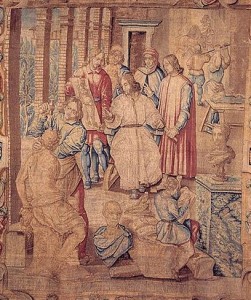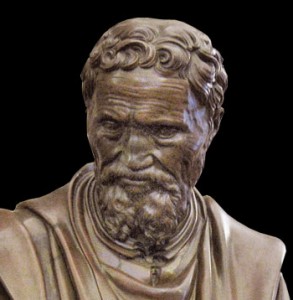
Designed by Johannes Stradanus
“Lorenzo de’ Medici in the Sculpture Garden,” 1571 [detail]
Tapestry, 167 5/16 x 179 1/8 in.
Museo Nazionnale di San Marco, Pisa
According to the Renaissance biographer Vasari, the day Michelangelo first visited Lorenzo de’Medici’s garden he noticed Torrigiani making small clay figures. Michelangelo thought he could do better, found some clay, and preceded to do just that. Torrigiani learned quickly that he was now facing a formidable rival. Soon his fellow students were studying the new arrival’s drawings, not his. At the dinners in the Medici Palace, he couldn’t help noticing that Michelangelo was often found sitting next to Lorenzo de’Medici himself — closer than il Magnifico’s own children.
The Medici garden was an ideal school for young artists. Pupils could not only learn from one of Donatello’s students, but also see the early Renaissance master’s sculptures, like his famous David, as they wandered its paths. Lorenzo de’Medici also had a superb collection of Renaissance paintings and ancient Roman sculptures that were available for first hand study.
But in the late 1400s, not just these gardens but all of Florence was a school for young artists. With paper and chalk in hand, they could be found throughout the city, roving street gangs of young draftsmen. Many of the altarpieces that now hang in the Uffizi Museum were still in their original locations in the great Florentine churches. One of the most popular drawing sites was the Brancacci Chapel in the Church of Santa Maria del Carmine. Inside were the revolutionary frescoes of the greatest Florentine painter of the 1400s — Masaccio. These paintings of biblical stories had unprecedented sculptural forms and incorporated the new mathematical rules of perspective (discovered by Masaccio’s friend, Brunelleschi). They were avidly studied by the young artists of Florence.
One day, as Torrigiani later related, both he and Michelangelo were sketching in the Brancacci Chapel. According to Torrigiani,
Buonarroti and I used, when we were boys to go into the Church of the Carmine to learn drawing from the Chapel of Masaccio. It was Buonarroti’s habit to banter me [insult], and one day, when he was annoying me, I got more angry than usual and clenching my fist, I gave him such a blow on the nose that I felt bone and cartilage go down like a biscuit beneath my knuckles; and this mark of mine he will carry with him to his grave.
That last statement proved to be true as we can see in the portrait bust of Michelangelo sculpted when the great artist was in his eighties and near the end of his life. Danielle de Volterra, one of the master’s most valued assistants, made it at the request of Michelangelo’s family with the idea that it would ultimately be on his tomb. The mark of Torrigiani’s punch — his flattened nose — is quite evident more than seventy years later.
The mark can also be said to have been on Torrigiani, too. Even though as an adult Torrigiani would go to England and become the court sculptor for King Henry VIII, he will always be best known as the artist who broke the nose of the greatest master of the Renaissance.


